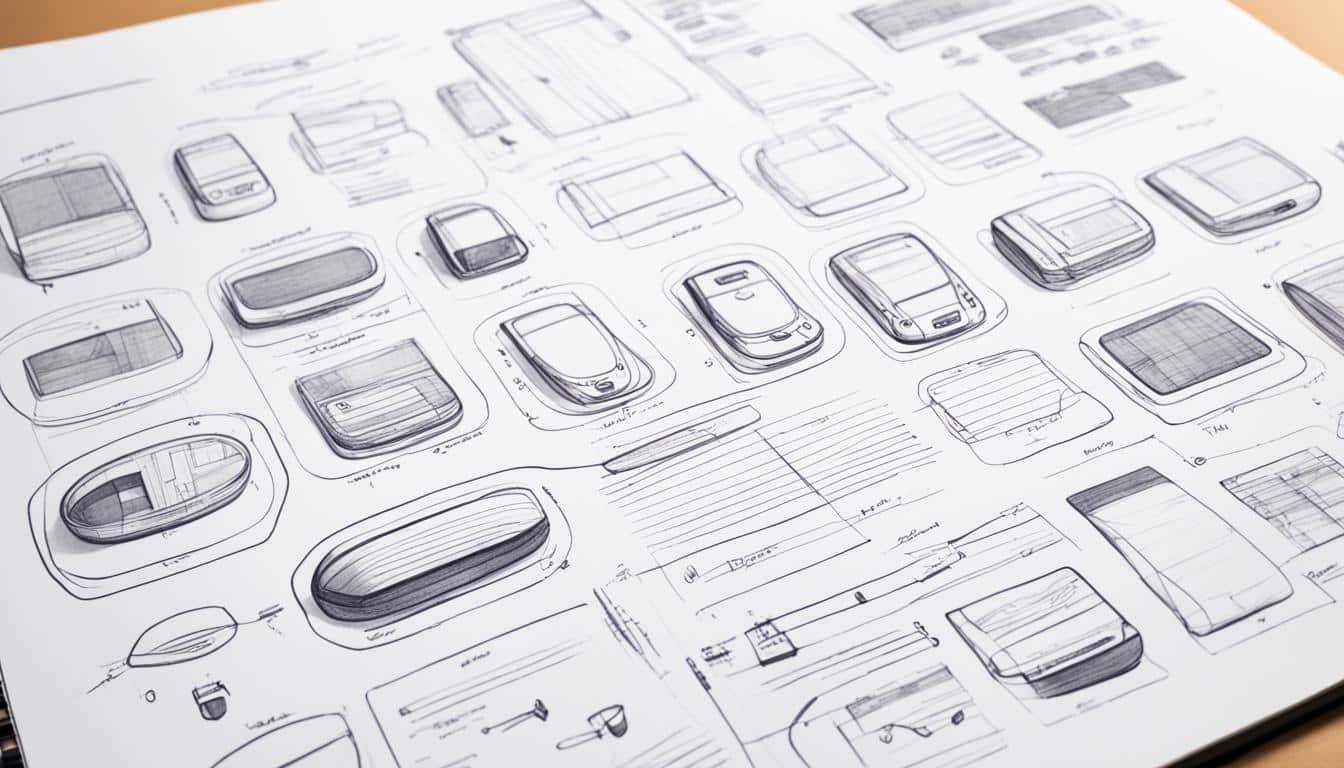Navigating Product Development: From Idea to Market
Have you ever wondered how new products come to life? From the initial spark of an idea to a fully launched product in the market, the process of product development is intricate and requires careful planning, innovation, and strategy. But what are the essential steps to make this journey successful? How can you transform your ideas into tangible products that meet customer needs and stand out in a competitive market?
In this article, we will guide you through the six stages of product development, providing expert strategies and insights for each step of the way. We will explore the importance of prototype design, market research, product testing, and new product launch. Join us on this journey as we demystify the process and empower you with the knowledge to navigate product development effectively.
Key Takeaways:
- Product development is a multi-stage process that starts with ideation and ends with successful market launch.
- Market research, prototype design, and product testing are crucial steps to ensure the viability and success of a new product.
- An iterative design approach and innovation strategy are key to refining and improving products throughout the development process.
- Concept development, commercialization, and product lifecycle management are also integral parts of product development.
- By following best practices and considering customer needs and market demand, you can increase the chances of effectively navigating the product development journey.
Understanding the Product Development Process
The product development process involves several key stages that are essential for creating successful products. Each stage plays a vital role in bringing a product from ideation to market. Let’s take a closer look at the stages involved in the product development process:
1. Ideation and Research
During the ideation and research stage, product managers identify customer needs and market gaps. They brainstorm and generate ideas to find solutions that address these needs. This stage also involves conducting in-depth market research to gain insights into the target market, customer preferences, and competition.
2. Product Definition and Strategy
Once the initial ideas are generated, the product definition and strategy stage comes into play. Product managers define the features and specifications of the product, keeping in mind the identified customer needs. They also identify the target audience and develop a comprehensive go-to-market plan to ensure a successful product launch.
3. Development and Design
In the development and design stage, a prototype of the product is created based on the defined features and specifications. It is then refined through feedback and iterations to ensure that it meets customer expectations. This stage requires effective collaboration between product managers, designers, and engineers to bring the product to life.
4. Testing and Launch
The testing and launch stage involves thorough testing of the product to ensure its functionality, usability, and durability. Product managers conduct various tests and gather feedback to identify any issues or areas for improvement. Once the product is deemed ready, it is prepared for market launch, including activities such as packaging, pricing, and distribution.
5. Post-Launch Analysis
After the product is launched, the post-launch analysis stage begins. Product managers analyze the product’s performance, collect customer feedback, and monitor key metrics to evaluate its success in the market. This analysis helps identify areas of improvement and informs future product development decisions.
Throughout the product development process, product managers play a crucial role. They are responsible for conducting market research, defining the product, coordinating teams, creating go-to-market plans, testing the product, and analyzing its performance. By effectively managing each stage, product managers can navigate the product development process successfully.
Ideation and Research
Ideation and research are crucial stages in the product development process. During ideation, product managers brainstorm and generate ideas, focusing on customer problems and finding solutions. By keeping the target customers’ needs in mind, they can generate valuable insights and creative concepts for new products. This phase is all about thinking outside the box and exploring innovative ideas.
Once the ideation phase is complete, it’s time to dive into market research. Comprehensive market research helps product managers gain a deeper understanding of the target market, customer preferences, and emerging trends. By conducting market research, product managers can:
- Identify potential customers and their needs
- Explore the competitive landscape and analyze competitors
- Identify market gaps and opportunities
Market research provides valuable insights that inform the product development strategy. It helps in formulating a clear roadmap and defining the right approach to take the product from concept to market success.
Another critical aspect of the research phase is gathering customer feedback. Engaging with potential customers and collecting their insights is invaluable in shaping the product’s features, functionality, and user experience. Customer feedback ensures that the product aligns with their needs and preferences. By actively involving customers in the development process, product managers can create products that truly resonate with the target audience.
Competitor analysis is another essential component of the research phase. By analyzing competitors’ products, pricing strategies, marketing approaches, and customer feedback, product managers can gain insights into the competitive landscape. This knowledge helps them identify competitive advantages and differentiate their product in the market.
The product development strategy is formulated based on the insights and findings from ideation and research. It outlines the key objectives, timelines, resource allocation, and go-to-market plan. This strategy serves as a roadmap for the product development process, guiding decision-making and ensuring alignment with business goals.
A SWOT analysis can further enhance the product development strategy. Evaluating the product’s strengths, weaknesses, opportunities, and threats provides a comprehensive understanding of its potential in the market. This analysis assists product managers in making informed decisions and refining the product’s value proposition.
Market research and customer feedback help product managers gain insights into the target market and identify opportunities for innovation.
Overall, the ideation and research stages require curiosity, a customer-first mindset, and the ability to challenge and refine initial ideas based on research and feedback. Conducting thorough market research, analyzing customer insights, and understanding the competitive landscape are critical steps in formulating a successful product development strategy.
Product Ideation and Research Process
The product ideation and research process can be broken down into the following steps:
- Brainstorm ideas: Generate a wide range of ideas and concepts that address customer problems and needs.
- Evaluate feasibility: Assess the feasibility of each idea considering factors such as technical challenges, resources, and market demand.
- Conduct market research: Gather market insights, identify target audience, analyze competitors, and understand emerging trends.
- Collect customer feedback: Engage with potential customers, collect their insights, and incorporate their feedback into the product development process.
- Perform a SWOT analysis: Evaluate the product’s strengths, weaknesses, opportunities, and threats to refine the product development strategy.
- Formulate the product development strategy: Based on the research findings, define key objectives, timelines, resource allocation, and go-to-market plan.
By following this process, product managers can ensure that the ideation and research stages contribute to the development of innovative and successful products.
Competitor Analysis
Competitor analysis plays a vital role in the product development process. By studying competitors, product managers gain valuable insights that inform their decision-making. Key aspects of competitor analysis include:
- Product features: Analyze the features and functionalities of competitors’ products.
- Pricing strategies: Understand how competitors position their products in the market in terms of pricing.
- Marketing approaches: Evaluate competitors’ marketing strategies, including channels, messaging, and promotions.
- Customer feedback: Analyze customer reviews and feedback to identify gaps and areas for improvement.
By conducting a thorough competitor analysis, product managers can identify opportunities, understand consumer preferences, and position their product effectively in the market.
| Product | Features | Pricing | Marketing Approach |
|---|---|---|---|
| Product A | Diverse feature set, but lacks integration with popular platforms | High-end pricing, positioned as a premium product | Online advertisements targeting professionals |
| Product B | User-friendly interface with limited features | Low pricing, positioned as an affordable solution | Influencer partnerships and social media engagement |
| Product C | Robust features with seamless integration | Mid-range pricing, attractive for small businesses | Industry conferences and direct sales approach |
The table above showcases a comparison of key competitors in terms of product features, pricing strategies, and marketing approaches. This information helps product managers gain insights into the competitive landscape and identify opportunities to differentiate their product.
Prototyping and Design
Prototyping and design are crucial stages in the product development process. During the prototyping phase, a sample or template of the final product is created to undergo multiple iterations and testing. This allows the development team to refine the design based on feedback and specific requirements, ensuring that the product meets the needs and expectations of the customers.
A clear communication of the product’s functionality, materials, and components is essential during this stage. The designers and engineers work together to finalize the product’s concept, making important decisions about its business plans and pricing ranges.
To facilitate the smooth progress of the design process, the team adopts an iterative design approach. This approach allows for constant refinement and improvement of the product design, based on continuous feedback and thorough testing.
Through prototyping and design, the product development team aims to achieve a well-crafted and functional product that delivers an exceptional user experience.
Materials and Mockups
During the prototyping and design stage, careful consideration is given to the selection of materials that best represent the final product’s intended features and functionality. From the choice of raw materials to the specific components, each element is thoughtfully evaluated to ensure optimal performance and durability.
Mockups, or physical representations of the product, are also created to provide a tangible experience and allow for better visualization of the design. These prototypes give stakeholders, such as investors and potential customers, an opportunity to provide valuable feedback and insights into the product’s form and function.
By leveraging high-quality materials and creating accurate mockups, the product development team is equipped to make informed decisions and iterate on the design to achieve the desired outcome.
Iterative Design Approach
The iterative design approach plays a fundamental role in the prototyping and design stage. This approach emphasizes frequent and incremental refinements based on user feedback, ensuring that the final product effectively addresses customer needs and pain points.
By continuously testing and gathering feedback at each iteration, design flaws and usability issues can be identified and resolved. This iterative process allows for greater flexibility, adaptability, and opportunity to fine-tune the product design before moving forward with production and commercialization.
The iterative design approach fosters collaboration and encourages a user-centric mindset within the product development team. By embracing feedback-driven improvements, the team can create a product that exceeds expectations and delivers exceptional value to the end-users.
Testing and Validation
Testing and validation are crucial steps in the product development process. These phases ensure that the product meets the highest standards of quality, functionality, and durability before it reaches the market. Comprehensive product testing is conducted to assess the performance and reliability of the prototype.
During the testing phase, customer feedback plays a vital role. By seeking input from potential users, product managers can gather valuable insights and identify any areas that require improvement. This customer-centric approach helps to refine the product and ensure it aligns with the needs and preferences of the target market.
Stress testing is another important aspect of the validation process. This involves subjecting the product to extreme conditions or intense use cases to determine its strength and endurance. By simulating real-world scenarios, stress testing identifies any weak points or potential failures, allowing product teams to make necessary adjustments.
In addition to user testing and stress testing, organizations may opt for test marketing. Test marketing involves releasing the product to a limited audience to gauge market interest and gather feedback. This step provides valuable insights into potential challenges or opportunities that may arise during the product’s full-scale launch.
To ensure that the product meets industry standards and regulatory requirements, quality assurance processes and certifications may also be implemented. Quality assurance guarantees that every aspect of the product’s development adheres to predefined specifications and meets the highest quality benchmarks.
Benefits of Testing and Validation
- Ensures the product meets customer expectations and demands
- Identifies and addresses potential issues or defects
- Improves product performance, functionality, and durability
- Enhances customer satisfaction and loyalty
- Reduces the risk of product recalls or negative publicity
- Builds trust and credibility with customers
Product Development and Manufacturing
In the product development and manufacturing stage, the product undergoes the necessary processes to bring it to market. This stage involves collaboration with manufacturers and logistics providers to ensure a seamless production process. Attention is given to manufacturing efficiency and cost optimization to maximize profitability. The design for manufacturability is a critical consideration, making adjustments to the product design to facilitate mass production while maintaining quality standards.
One important aspect of this stage is packaging development, which takes into account the customer experience and retention. The packaging design aims to create a visually appealing and functional package that effectively showcases the product and protects it during shipping and handling.
Before the product is ready for market, quality checks and validation are performed. These processes ensure that the product meets the required specifications and complies with industry standards. Validation eliminates any defects or flaws, guaranteeing customers a high-quality product.
Manufacturing and Production Process
The manufacturing and production process involves several key steps to transform the product design into a tangible, market-ready item. These steps may include:
- Raw Material Procurement: Sourcing the necessary raw materials for production.
- Assembly: Assembling the components and parts to create the final product.
- Testing: Conducting rigorous testing to ensure the product meets quality standards and functions as intended.
- Packaging: Packaging the product in an attractive and protective manner.
- Shipping and Distribution: Coordinating the logistics to transport the product from the manufacturing facility to distribution centers or directly to retailers.
Throughout the manufacturing and production process, continuous monitoring and quality control measures are implemented. These measures help identify any potential issues or defects in real-time, allowing for immediate resolution and ensuring a high standard of quality.
Product Manufacturing Challenges
Product development and manufacturing can present several challenges that require careful management:
- Manufacturability: Ensuring that the product design is optimized for efficient and cost-effective mass production. This involves assessing the feasibility of the design, identifying any potential manufacturing limitations or constraints, and making necessary adjustments.
- Supply Chain Management: Establishing strong relationships and effective communication with suppliers to ensure a reliable and timely supply of raw materials and components. This includes managing inventory levels and mitigating any potential disruptions that may impact production.
- Quality Assurance: Implementing robust quality control processes to maintain consistent product quality. This involves conducting inspections, tests, and audits throughout the manufacturing process to identify and address any deviations from the desired specifications.
- Cost Optimization: Balancing the need for high-quality materials and efficient production processes with cost considerations. This includes identifying opportunities for cost savings without compromising the product’s functionality or quality.
Key Considerations for Product Development and Manufacturing
| Consideration | Description |
|---|---|
| Collaboration | Involving manufacturers and logistics providers to ensure smooth production, timely delivery, and cost optimization. |
| Design for Manufacturability | Making adjustments to the product design to facilitate efficient and cost-effective mass production. |
| Packaging Development | Creating visually appealing and functional packaging that enhances the customer experience and protects the product. |
| Quality Checks and Validation | Performing rigorous quality checks and validation processes to ensure the product meets specifications and complies with standards. |
The product development and manufacturing stage is a critical phase in bringing a product to market. It involves close collaboration with manufacturers, meticulous attention to detail, and adherence to quality standards. By considering key factors such as manufacturability, packaging, and quality assurance, organizations can successfully navigate this stage and prepare their product for a successful market launch.
Commercialization and Marketing
Commercialization is a critical stage in the product development process, as it involves the launch of a product into the market and the development of a comprehensive marketing strategy. At this stage, a go-to-market plan is implemented, which encompasses various aspects, such as pricing, distribution, and promotion strategies, to ensure a successful product launch.
One of the key components of commercialization is the development of a robust marketing strategy. This entails creating a detailed plan to reach potential customers, support existing users, and ensure the continuous delivery of the product. A well-crafted marketing strategy helps create awareness about the product, generate sales, and build brand loyalty.
Key performance indicators (KPIs) and metrics are crucial in measuring the success of the product during this stage. By defining specific KPIs and metrics, companies can effectively monitor the performance of their product in the market. These indicators can include sales figures, customer satisfaction ratings, customer acquisition costs, and market share, among others. Regular tracking and analysis of these metrics provide valuable insights into the effectiveness of the marketing efforts, enabling companies to make informed decisions and optimize their strategies accordingly.
| Key Performance Indicators (KPIs) | Metrics |
|---|---|
| Product Revenue | Measure of the product’s financial performance and profitability |
| Customer Acquisition Cost (CAC) | The cost of acquiring a new customer, including marketing and sales expenses |
| Customer Lifetime Value (CLTV) | Predicts the net profit generated by a customer throughout their relationship with the company |
| Market Share | Measures the portion of the total market a product occupies |
| Customer Satisfaction | Quantifies the level of satisfaction customers have with the product or service |
Implementing effective marketing strategies during the commercialization stage involves various activities, such as advertising, public relations, digital marketing, social media promotions, and influencer marketing. These initiatives aim to create brand awareness, generate leads, and drive sales for the product.
Additionally, companies need to develop a well-defined go-to-market plan that outlines the specific steps and strategies to successfully launch the product in the market. This includes determining the target audience, identifying distribution channels, and establishing pricing strategies that align with market demands.
By focusing on product commercialization and marketing, companies can maximize their product’s potential and increase its chances of success in the competitive market. A well-executed marketing strategy and a comprehensive go-to-market plan lay the foundation for a successful product launch, enabling companies to achieve their marketing and sales objectives.
Post-Launch Analysis and Adjustments
Once the product is launched, it’s essential to conduct a thorough post-launch analysis to evaluate its performance and gather valuable customer feedback. This analysis allows you to identify areas of improvement and make necessary adjustments to ensure the product’s success in the market.
One of the key aspects of post-launch analysis is analyzing sales data. By closely examining the product’s sales figures, you can gain insights into its market acceptance and identify patterns or trends. This information provides valuable guidance for making data-driven decisions regarding future enhancements and adjustments.
In addition to sales data, customer feedback plays a pivotal role in post-launch analysis. Collecting feedback from customers who have purchased and used the product offers valuable insights into their experiences, preferences, and expectations. This feedback can be gathered through surveys, reviews, or direct communication channels, providing you with valuable insights for refining the product.
Performance tracking throughout the post-launch phase is also crucial. By continually monitoring key performance indicators (KPIs), such as customer satisfaction ratings, product usage metrics, and market share, you can measure the product’s success and identify any issues that need to be addressed promptly.
Continuous improvement is an integral part of the post-launch analysis process. By reviewing the gathered data and insights, you can identify specific areas where adjustments or enhancements can be made to better meet customer needs and preferences. These improvements can range from minor tweaks to significant updates and feature additions, ensuring that the product continues to evolve and remain competitive in an ever-changing market.
Benefits of Post-Launch Analysis and Adjustments:
- Identify areas of improvement for the product
- Enhance customer satisfaction and experience
- Stay ahead of competitors through continuous improvement
- Optimize product performance based on data-driven insights
- Maximize market penetration and growth
By prioritizing post-launch analysis and incorporating customer feedback, performance tracking, and product adjustments, you can ensure the continuous improvement and success of your product.

Product Manager Responsibilities
Product managers play a crucial role in the product development process. They have a wide range of key responsibilities that contribute to the success of a product from start to finish.
Market Research
One of the primary responsibilities of a product manager is conducting thorough market research. This involves analyzing industry trends, understanding customer needs and preferences, and identifying market opportunities. By gathering and analyzing this data, product managers can make informed decisions to guide the development and positioning of a product.
Product Definition and Strategy
Product managers are responsible for clearly defining the features, functionalities, and value proposition of a product. They work closely with cross-functional teams to develop a comprehensive product strategy that aligns with the company’s goals and addresses customer needs.
Coordination and Team Management
Product managers play a critical role in coordinating and managing various teams involved in the product development process. They collaborate with designers, engineers, marketers, and other stakeholders to ensure effective communication, resource allocation, and timely execution of tasks.
Go-to-Market Planning
Creating a successful go-to-market plan is another important responsibility of product managers. They develop strategies for pricing, distribution, promotion, and customer acquisition to ensure a smooth product launch and maximize market penetration.
Testing and Analysis
Product managers oversee the testing phase of a product, ensuring that it meets quality standards and customer expectations. They gather feedback from users, conduct user acceptance testing, and analyze performance data to make data-driven decisions for product improvements.
Continuous Improvement
Product managers are constantly analyzing market trends, customer feedback, and product performance to identify areas for improvement. They use this information to iterate on the product, implementing changes and updates that enhance its value and address emerging customer needs.
Overall, product managers play a vital role in every stage of the product development process, from ideation to post-launch analysis. They combine strategic thinking, market research, coordination, and analysis to ensure the successful development and launch of innovative products.
Other Methods of Product Development
While the six-step process described earlier is a common approach to product development, there are other methods that can be followed. These alternative methods offer flexibility and the opportunity for fast, feedback-driven iterations. Let’s explore two popular approaches: agile product development and the minimum viable product (MVP) approach.
Agile Product Development
Agile product development is an iterative approach that emphasizes collaboration, adaptability, and customer feedback. It employs short cycles called sprints, typically lasting two to four weeks, to break down work into smaller parts. This allows for quicker implementation and evaluation of ideas. The iterative nature of agile development means that adjustments, improvements, and refinements can be made based on the feedback received during each sprint. This feedback-driven approach leads to a more customer-centric product as it evolves over time.
Minimum Viable Product (MVP) Approach
The minimum viable product (MVP) approach focuses on developing a basic version of the product that is sufficient to gather feedback from customers or investors. The MVP is designed to test the market and validate assumptions in the shortest possible time. By building only the core features necessary for the product to function, resources can be allocated efficiently. This approach allows for rapid product validation and iteration, avoiding the risk of investing significant resources in a product that doesn’t meet market demand. With the feedback received from initial users, the product can be enhanced and expanded to meet customer needs.
Both agile product development and the minimum viable product (MVP) approach offer effective alternatives to the traditional six-step process. These methods enable shorter development cycles, more frequent iterations, and a greater emphasis on customer feedback. By embracing these alternative approaches, companies can increase their chances of creating successful, customer-centric products.
| Key Features | Agile Product Development | Minimum Viable Product (MVP) Approach |
|---|---|---|
| Iterative Approach | Yes | Yes |
| Short Cycles | Yes | Yes |
| Feedback-Driven Iterations | Yes | Yes |
| Focus on Customer Needs | Yes | Yes |
| Resource Efficiency | No | Yes |
Conclusion
The product development process is a complex journey that spans from ideation to successful market launch. It requires a strategic approach, attention to detail, and a customer-first mindset. By following a structured method and considering key factors such as market demand, competition, and financial resources, organizations can increase their chances of developing successful products.
Effective product management is crucial throughout the entire process, ensuring clear communication, coordination, and alignment of teams. Collaboration with various stakeholders, including sponsors, internal teams, suppliers, and customers, is essential for a smooth product development journey.
Continuous improvement is a key aspect of successful product development. It involves thorough research, testing, commercialization, and post-launch analysis. By constantly analyzing performance, collecting customer feedback, and making necessary adjustments, organizations can navigate the product development process and achieve successful product launches. With the right approach and relentless dedication, organizations can turn their innovative ideas into tangible products that meet customer needs and drive business growth.







